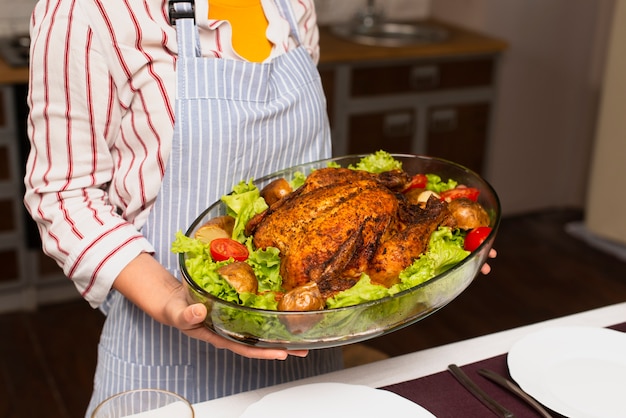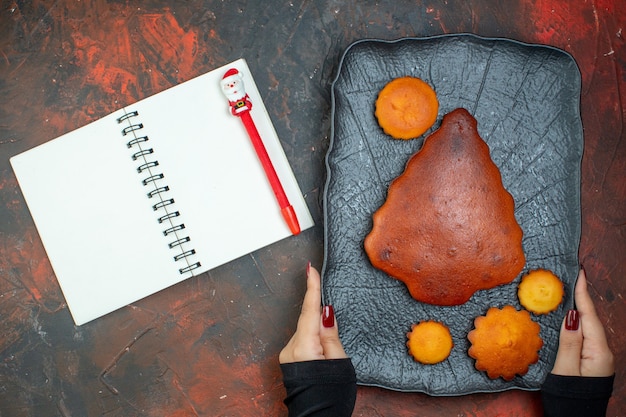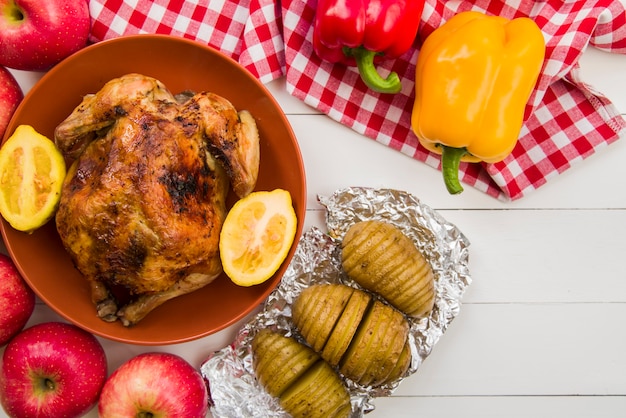Part 1: Turkey Triumphs and Tales: From Kitchen Chaos to Feasting Glory

There’s nothing quite like the smell of roast turkey filling your house, right? It's a beautiful thing. But let's be honest, a 19-pound bird is no small feat. It’s a commitment, a labour of love, and a bit of a rollercoaster of emotions. You've got the initial excitement of getting started, followed by the nervous anticipation of checking the bird every 15 minutes, and then the glorious moment when it's finally done! It's a journey, that's for sure, but one that's worth every minute.
I remember the first time I tackled a turkey this size. It felt like I was wrestling a small dinosaur! I was terrified of undercooking it (and equally terrified of overcooking it, resulting in a dry, leathery bird). And I swear, that oven thermometer felt like it was mocking me. It kept going up and down, making me question my sanity. But I persevered, and after what felt like an eternity, I finally pulled out a beautiful, golden-brown turkey. It was a moment of triumph!
Part 2: The Golden Rule: Time and Temperature

Now, before we dive into the details, let's get the basics down. The golden rule of turkey roasting is this: Cook it at 325°F (160°C) for about 13-15 minutes per pound. Of course, there's a bit more to it than that, but it's a great starting point.
But remember, the exact cooking time depends on a few things, like the size of your bird, whether it's stuffed or not, and your oven's quirks. Some ovens run hotter than others. So, it's always best to check the internal temperature to make sure it's done.
Part 3: The turkey thermometer: Your Best Friend

Speaking of checking the temperature, this is where your turkey thermometer comes in. It’s like the superhero of your roasting adventure. I've learned this the hard way. One year, I was so convinced my turkey was done based on the timer, but the thermometer told a different story. It was way undercooked! Let's not go there again.
So, stick the thermometer into the thickest part of the thigh, without touching the bone. You want the internal temperature to reach 165°F (74°C). The thermometer will give you a definitive answer and help you avoid any food safety risks. Don't rely solely on timing; trust the thermometer!
Part 4: The Art of Basting: A Little Love and Butter
Now, this part is optional but highly recommended. Basting, my friends, is the key to a juicy and flavorful turkey. You see, as the turkey cooks, it dries out a bit. Basting with butter or broth helps keep it moist and succulent.
You can do it every 30-45 minutes while the bird is in the oven. It's a little bit of TLC for your turkey, and trust me, it makes a world of difference. I usually use a mixture of melted butter, chicken broth, and herbs. You could even use a simple mixture of olive oil and herbs. But you do you, experiment, find what works for you.
I like to use a basting brush, but you can also use a spoon. Just be careful not to let the hot drippings splatter on you! And don't forget to tent the turkey loosely with foil towards the end of cooking to prevent the skin from getting too dark.
Part 5: The Resting Period: Patience is a Virtue
Alright, the turkey's done, the oven's off, but don't go carving it just yet! This is where patience comes in. Let the turkey rest for about 15-20 minutes before carving. This allows the juices to redistribute throughout the meat, resulting in a much juicier and more flavorful turkey.
This is especially important for a larger bird. The longer the bird cooks, the more moisture it loses. Resting helps rehydrate the meat, so you don't end up with a dry turkey. Trust me, the wait is worth it!
Part 6: The Stuffing Dilemma: To Stuff or Not to Stuff
Now, let's talk stuffing. This is a bit of a controversial topic. Some people swear by stuffing their turkey, while others say it's a recipe for disaster. Personally, I'm on Team No Stuffing. Why? Well, stuffing can take longer to cook than the turkey, leading to undercooked turkey or overcooked stuffing. Plus, the juices from the turkey can leak into the stuffing, making it a bit soggy.
I prefer to cook my stuffing separately, either in a casserole dish or in the oven alongside the turkey. That way, both the turkey and the stuffing are cooked perfectly. However, if you are adamant about stuffing the turkey, make sure you cook it to a safe internal temperature of 165°F (74°C). And remember, stuffing should be cooked until it reaches 165°F (74°C) as well.
Part 7: turkey cooking Time Table for a 19-Pound Bird
Okay, you've got the basics, you've got the thermometer, you've got the basting game plan. Now, let's get specific. Here's a general timeline for roasting a 19-pound turkey. Remember, these are just estimates, so keep an eye on that thermometer and be ready to adjust your cooking time as needed.
| Stage | Time | Details |
|---|---|---|
| Pre-heating | 30 minutes | Preheat your oven to 325°F (160°C). |
| roasting time (unstuffed) | 4 hours 30 minutes - 5 hours | Roast at 325°F (160°C) for 13-15 minutes per pound. |
| Roasting Time (stuffed) | 5 hours - 5 hours 30 minutes | Roast at 325°F (160°C) for 13-15 minutes per pound. |
| Resting Time | 15-20 minutes | Let the turkey rest before carving. |
Part 8: turkey tips and Tricks: From Seasoning to Storage
Now, let's get to the nitty-gritty details of turkey roasting success!
Seasoning with Flair: The Flavor Explosion
When it comes to seasoning, the options are endless! But here are a few tips:
- Salt and pepper are essential. They bring out the natural flavors of the turkey. You can rub them directly onto the skin and inside the cavity.
- Herbs are your friends. Try rosemary, sage, thyme, or a blend of herbs. You can use fresh or dried herbs.
- Garlic and onion powder add depth of flavor. These can be rubbed on the turkey or added to the cavity along with the herbs.
- Don't overdo it. A little goes a long way. You don't want to overwhelm the turkey with flavor.
Turkey Prep: A Little Love Goes a Long Way
Before you put that bird in the oven, it's important to give it a little TLC.
- Pat the turkey dry. This will help the skin crisp up nicely. You can use paper towels to dry the turkey inside and out.
- Rub the turkey with butter. This adds moisture and flavor. Use softened butter or melted butter, and rub it all over the turkey, including under the skin.
- Place the turkey on a roasting rack. This allows air to circulate around the bird, ensuring even cooking. The rack also helps the turkey brown evenly.
Leftover Turkey: More Than Just Sandwiches
After all that work, you're likely going to have some leftover turkey. Don't let it go to waste! There are so many delicious ways to use leftover turkey.
- turkey sandwiches: A classic for a reason! Try adding cranberry sauce, mayo, and lettuce for a Thanksgiving-inspired sandwich.
- turkey soup or stew: A comforting and hearty meal. Add some vegetables, broth, and spices for a delicious and nutritious soup.
- turkey salad: Perfect for a light lunch or a dinner salad. Combine chopped turkey with mayo, celery, onion, and your favorite seasonings.
- turkey pot pie: A delicious and satisfying meal. Use leftover turkey in a creamy pot pie with a flaky crust.
Storage Tips: Keeping That Turkey Fresh
Leftover turkey should be stored in the refrigerator for up to 4 days. You can also freeze it for up to 2 months. When freezing, wrap the turkey tightly in freezer-safe plastic wrap or aluminum foil.
If you're freezing a whole turkey, consider dividing it into smaller portions for easier thawing. This will also make it easier to use the turkey in different recipes later on.
Part 9: FAQs: Your Turkey Questions Answered
Okay, you've got questions, I've got answers! Let's get to those frequently asked questions about roasting a turkey.
1. What if my turkey is a different size?
No worries! You can adjust the cooking time based on the weight of your turkey. Use the 13-15 minutes per pound rule as a guideline and check the internal temperature to ensure it's cooked through. For example, if you have a 15-pound turkey, you would cook it for 3 hours and 45 minutes to 4 hours and 15 minutes (15 pounds x 13-15 minutes per pound = 195-225 minutes).
2. Can I use a turkey brine?
Yes! Brining can help keep your turkey moist and flavorful. You can brine your turkey for 12-24 hours before roasting. Just make sure to rinse it thoroughly before roasting.
Brining involves soaking the turkey in a salt-water solution. This helps to draw moisture into the meat, resulting in a juicier turkey. You can find many different brine recipes online, but a simple brine is made with salt, water, and sugar.
3. What if my turkey skin is not getting crispy?
This can happen if your oven is too crowded. Try spreading the turkey out on a larger roasting rack or increasing the oven temperature to 400°F (200°C) for the last 30 minutes of cooking. You can also brush the skin with butter or oil to help it crisp up.
4. What can I do if my turkey is overcooked?
If you've accidentally overcooked your turkey, don't worry! It's still edible, it just might be a little dry. You can try to salvage it by making turkey soup or stew. The shredded turkey will be great in a soup or stew, and the overcooked meat will add a rich flavor to the broth.
5. How can I make my turkey more flavorful?
There are a few things you can do to make your turkey more flavorful:
- Brine it. As mentioned earlier, brining helps to infuse the turkey with moisture and flavor.
- Stuff it with herbs and aromatics. Fill the cavity of the turkey with herbs, onions, garlic, and citrus fruits for a more flavorful bird.
- Roast it with vegetables. Place root vegetables, like carrots, potatoes, and onions, around the turkey. The vegetables will absorb the juices from the turkey and become delicious side dishes.
- Baste it with butter, broth, or pan drippings. As mentioned before, basting helps to keep the turkey moist and flavorful.
Part 10: The Grand Finale: Your Turkey Feast
There you have it, folks! You're now equipped with the knowledge and confidence to roast a 19-pound turkey to perfection. Remember, it's all about patience, attention to detail, and a little bit of love. So, get your turkey, gather your friends and family, and get ready for a delicious feast. Happy roasting!
Everyone is watching

How to Cook Frozen Lobster Tails Perfectly: A Step-by-Step Guide
RecipesLobster. Just the word conjures up images of lavish meals, special occasions, and a taste of luxury. But let's...

Pigs in a Blanket Cooking Time: How Long to Bake for Perfect Results
RecipesAh, pigs in a blanket. Just the name conjures up images of those delightful little parcels of crispy pastry en...

Pork Fillet Cooking Time: How Long to Cook It Perfectly
RecipesPork fillet, or tenderloin as it's sometimes called, is a real favourite in our house. It's so versatile, and...

The Ultimate Guide to Cooking Delicious Frankfurters
RecipesLet's face it, we all love a good frankfurter. It's a classic, simple, and always satisfying. But let's be rea...

Wolf Meat Recipes: A Guide to Cooking Wild Game
RecipesLet's be honest, you don't see wolf meat at your local butcher shop every day. It's a bit of a wild card, but ...
